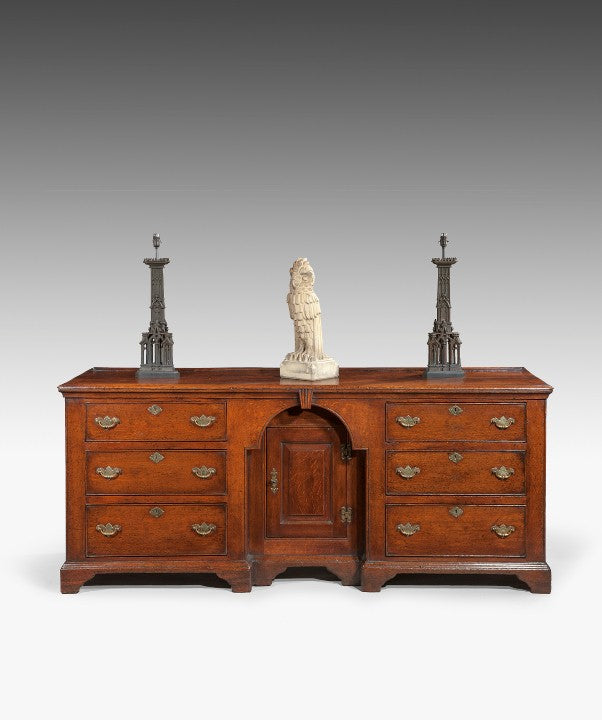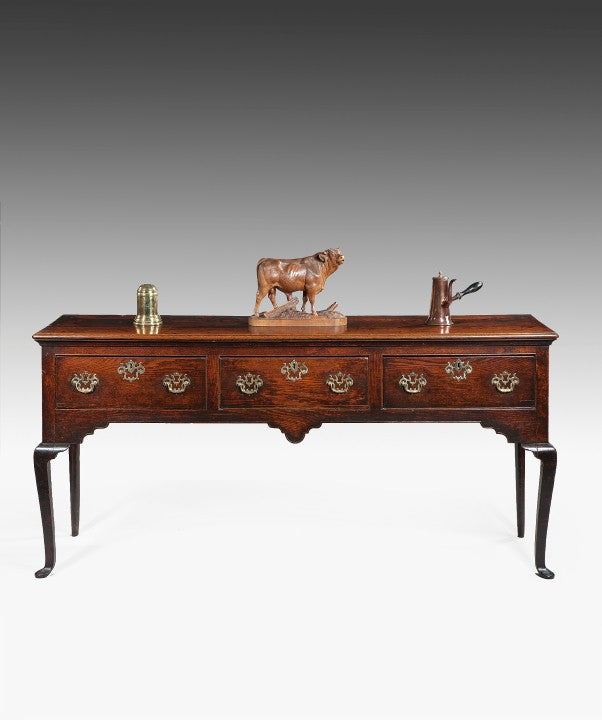A buyer's guide to antique oak dressers.
An antique oak dresser is one of the most useful and practical pieces of English antique furniture. Oak dressers are perfect in a traditional kitchen displayed with the family china but a dresser is also equally at home in a smart London townhouse with a piece of modern art displayed above it. Oak dressers offer a large amount of storage but will fit into most spaces because they are shallow from front to back.
When considering which antique oak dresser to purchase they can initially be split into two categories: dresser and racks and dresser bases. The former are ideal for a traditional kitchen where there rack allows you to an eclectic mix of old china and other pieces of interest. Usually the china would be displayed leaning backwards but with Scottish dressers there are bars across the rack so that the china can lean forwards reflecting fire light into a gloomy interior.

An oak dresser base lends itself to more situations; it can be used in a traditional setting but its versatiliy lends itself to a hallway, ideal for storing keys, gloves and other impedimenta or as a handsome cabinet in a dining room or drawing room. Oak due to its more rustic nature can make an interior feel less formal and stuffy than mahogany or rosewood furniture.
Antique oak dresser bases can then be split into four further categories: cupboard base dressers, cabriole leg dressers, straight leg dressers and potboard dressers. Oak cupboard base dressers offer the lagest amount of storage and their cabinet-work is often more complex and refined than the other types, the example illustrated below has an unusually architectural design with its central arch.

Oak cabriole leg dressers are usually the most elegant and therefore lend themselves to smart hallways and drawing rooms where they can be used as an alternative to a console table.

A straight leg oak dresser is a less elegant version of a cabriole leg dresser which accounts for their slightly lower value.

A potboard oak dresser was usually made as a less expensive alternative to a cupboard base dresser which is why they are often the most rustic in their design.
When buying an antique oak dresser it is particularly important to consider its colour and patination. Patination will give a dresser added depth to its surface colour and a sense of atmosphere whereas repolished oak tends towards an undesirable orangey colour. Oak dressers will often have replaced handles as they will probably have been used on a daily basis since their manufacture. If the handles have been replaced sympathetically this will not greatly effect the value of a dresser.
The construction techniques of a dresser are often fairly rudimentary as they were utilitarian pieces of furniture often made in the local village. So dovetails are thick and do not fit perfectly and drawer bottoms are often nailed on. However finer examples can be made just like mahogany furniture with crossbandings, carved architectural detailing and fielded panels.
This local tradition of oak dresser production led to marked regional variations especially with welsh dressers, the valleys prevented travel between different villages fostering a local style. The example illustrated below is typical of dressers made in the North Country with its inset quarter columns into the corners.

If you are interested in antique oak furniture you may enjoy our other blogs: Antique and Period Oak Furniture and The Humble Chair.

